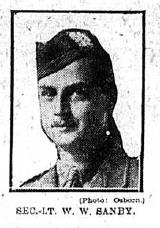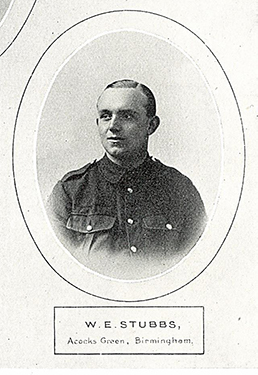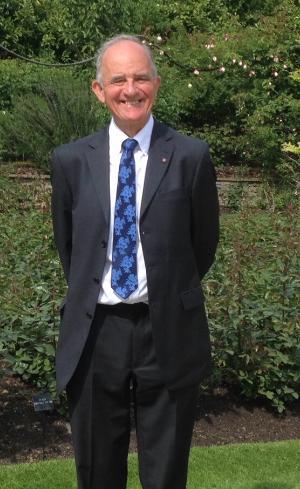Who’s for the Game?
23/05/2019 - 5.30
Douglas Smith
 There’s a field in a suburb of Birmingham, surrounded by 1960s houses, where cricket is played. It has been played here since 1900. Its pavilion was built in April 1914 and the cricket team’s men went to war in August 1914. 18 of them did not return nor did 12 of the men who played for the football team they started. Their deaths are recorded on a wooden memorial plaque in the entrance hall. Twenty yards to the right of the front door, until October 2018, was a stone memorial to one of the most famous rugby clubs in the country with a further 18 names. The land is owned by one of the oldest golf clubs in the city and its clubhouse has another wooden memorial with a further four names. My new book, ‘Who’s for the Game?’ tells the story of these men.
There’s a field in a suburb of Birmingham, surrounded by 1960s houses, where cricket is played. It has been played here since 1900. Its pavilion was built in April 1914 and the cricket team’s men went to war in August 1914. 18 of them did not return nor did 12 of the men who played for the football team they started. Their deaths are recorded on a wooden memorial plaque in the entrance hall. Twenty yards to the right of the front door, until October 2018, was a stone memorial to one of the most famous rugby clubs in the country with a further 18 names. The land is owned by one of the oldest golf clubs in the city and its clubhouse has another wooden memorial with a further four names. My new book, ‘Who’s for the Game?’ tells the story of these men.
Moor Green Football Club was formed in 1901 by members of Ashfield Cricket Club who so enjoyed the comradeship of playing cricket that they wanted to continue it in the winter months. They didn’t play ‘competitive’ matches until after the war. A large number of players from Ashfield also played for Moor Green although some played exclusively for Moor Green. These are just a few of their stories:
 2nd Lieutenant William Worthington Sanby 20th (Tyneside Scottish) Battalion Northumberland Fusiliers.
2nd Lieutenant William Worthington Sanby 20th (Tyneside Scottish) Battalion Northumberland Fusiliers.
Bill Sanby is one of my favourites. He was quite tall and so I see him as a Centre Half. He joined the 14th Battalion (1st Birmingham Pals) Royal Warwickshire Regiment at the start of the war and was Lance Corporal 764. On 16th April 1915 he was commissioned in the Northumberland Fusiliers. He went to France in January 1916. On 1st July 1916 they attacked at La Boisselle over the 800 yards of No Man’s Land in Mash Valley. William and the majority of his battalion were cut down by machine-gun fire and although a few isolated parties made the front line they were ultimately all killed. William’s body was never recovered, but he is commemorated on the Thiepval Memorial. He died aged 21 on 1st July 1916 and is remembered on the Thiepval Memorial.
 The Somme went to claim two Moor Green players on the same day: Private William Ernest Stubbs 996 14th Battalion Royal Warwickshire Regiment and Private John Edward Chilton Price 14/295 "B" Company 14th Battalion Royal Warwickshire Regiment.
The Somme went to claim two Moor Green players on the same day: Private William Ernest Stubbs 996 14th Battalion Royal Warwickshire Regiment and Private John Edward Chilton Price 14/295 "B" Company 14th Battalion Royal Warwickshire Regiment.
The Battalion landed at Boulogne on 21st November 1915 and William spent his entire military career in France. The Battalion was part of the attack on High Wood on the night of 22nd/23rd July. The Germans had regained most of the wood after twice almost being in the hands of the British and held the Pommiers Redoubt. The 14th Battalion along with 1st Royal West Kents attacked the south-eastern part of the wood and Wood Lane whilst the 4th Gordon Highlanders attacked the eastern corner of the wood. There was a preliminary bombardment but this wasn’t sufficient to cause sufficient casualties amongst the Germans who were caused awful casualties amongst the attacking forces. No sufficient gains were made and the attack was called off. The Royal West Kents suffered 420 casualties. The 14th Warwickshires were also decimated with 194 casualties. William Stubbs was reported missing on 23rd July 1916, later presumed killed, aged 20. As his body was never recovered, William is commemorated on the Thiepval Memorial. John Price died aged 24 on 23rd July 1916. He is buried in Caterpillar Valley Cemetery.
 Another player died three days later. 2nd Lieutenant Rowland Evan Basil Rowlands 16th Battalion (3rd Birmingham Pals) Royal Warwickshire Regiment. On the 27th July, at 7.10 am, the British Fourth Army resumed their offensive upon Longueval and Delville Wood. The guns opened up from both sides with hot metal filling the air and the ground peppered with blasts. The 16th Battalion attacked with a creeping barrage for the first time against an enemy well dug in and making use of the numerous fortified cellars in Longueval. Bitter fighting followed as both sides fought from fortified point to fortified point. The Battalion lost 267 soldiers, with 57 killed and 45 never recovered. Captain James Holmes recorded that he met Rowland at the edge of the wood. He told him that he was quite certain that he was going to be killed. Holmes tried to cheer him up. Holmes moved away and when he came back to where Rowland was with his men there was a big shell hole and no sign of Rowland. He died aged 26 on 27th July 1916 and is remembered on the Thiepval Memorial.
Another player died three days later. 2nd Lieutenant Rowland Evan Basil Rowlands 16th Battalion (3rd Birmingham Pals) Royal Warwickshire Regiment. On the 27th July, at 7.10 am, the British Fourth Army resumed their offensive upon Longueval and Delville Wood. The guns opened up from both sides with hot metal filling the air and the ground peppered with blasts. The 16th Battalion attacked with a creeping barrage for the first time against an enemy well dug in and making use of the numerous fortified cellars in Longueval. Bitter fighting followed as both sides fought from fortified point to fortified point. The Battalion lost 267 soldiers, with 57 killed and 45 never recovered. Captain James Holmes recorded that he met Rowland at the edge of the wood. He told him that he was quite certain that he was going to be killed. Holmes tried to cheer him up. Holmes moved away and when he came back to where Rowland was with his men there was a big shell hole and no sign of Rowland. He died aged 26 on 27th July 1916 and is remembered on the Thiepval Memorial.
To give an example of some from the other Birmingham Battalion there is Lance Corporal Charles Chester Illingworth 15th Battalion (2nd Birmingham Pals) Royal Warwickshire Regiment. Charles’s father was Captain of Kings Heath Cricket Club and so I assume that Charles played football for Moor Green rather than cricket for Ashfield. On 3rd September his Division, the 5th, was involved in the Battle of Guillemont (3rd- 6th September 1916). Guillemont was on the right flank of the British line since the middle of July and had been continuously attacked without success during August. This Battle was intended to finally capture it. It was essential to capture it if the French and British were to cooperate properly north of the Somme which would then lead to attacks on Flers and Courcelette. The 5th Division were on the right of this attack with their target being Leuze Wood, 1,500 yards beyond the village, on a ridge overlooking the village of Combles. There were heavy casualties as the troops advanced through murderous rifle and machine gun fire. Despite this the 5th Division captured its first three objectives and reached a line east of Guillemont. He died aged 20 on 3rd September 1916 and is remembered on the Thiepval Memorial.
Finally there is a player who died after a road accident, Captain Sydney Graham Halsey 9th Battalion Cheshire Regiment. He was an extremely lucky man as he came through the war without a scratch. He was killed on 30th March 1920 whilst riding a motorcycle and sidecar which was in collision with a tram on the corner of Russell Road and Edgbaston Road and so why was he included on the War Memorial? I wonder whether he ever came to terms with the fact that he had seen so many of his friends and fellow soldiers killed and maimed and yet he emerged from the war without a scratch!
WE WILL REMEMBER THEM.
 Biography
Biography
Douglas was educated at Sheldon Heath Comprehensive School having failed his 11 plus which was a stroke of good fortune because he assumed it was because he wasn’t bright and therefore had to work much harder. Sheldon was an excellent school with committed teachers. It gave Douglas opportunities to achieve and he went to Worcester College of Education and came out with a Bachelor of Education Degree. He then taught in Birmingham schools for the next 38 years, gaining a Masters of Education Degree in 1984 before finally retiring in 2011. Douglas was awarded an M.B.E. for services to Education in 2012. Since retiring he has become a speaker and author. Douglas has had three books published all based on the First World War. They are:
‘From Trams to Trenches’ which tells the story of the members of the Birmingham Tramways Department who died in the war.
‘Cheer Boys it’s Hartlebury’ which is based on original autograph books left by the soldiers who attended Hartlebury VAD Hospital in the First World War.
‘Who’s for the Game?’ which is the unique story of the men from four Birmingham sports clubs, Moseley Rugby, Moor Green Football, Ashfield Cricket Club, and Moseley Golf Club who died in the war.
You can find Douglas on Twitter at @Historydoug and his website is - www.Historynut.co.uk


/prod01/wlvacuk/media/departments/digital-content-and-communications/images-2024/240624-Alumni-Awards-2024-Resized.jpg)
/prod01/wlvacuk/media/departments/digital-content-and-communications/images-18-19/220325-Engineers_teach_thumbail.jpg)
/prod01/wlvacuk/media/departments/digital-content-and-communications/images-2024/240627-UN-Speaker-Resized.jpg)
/prod01/wlvacuk/media/departments/digital-content-and-communications/images-2024/240320-Uzbekistan-Resized.jpg)
/prod01/wlvacuk/media/departments/digital-content-and-communications/images-2024/240229-The-Link-Resized.jpg)
/prod01/wlvacuk/media/departments/digital-content-and-communications/images-2024/240627-Lady-Aruna-Building-Naming-Resized.jpg)